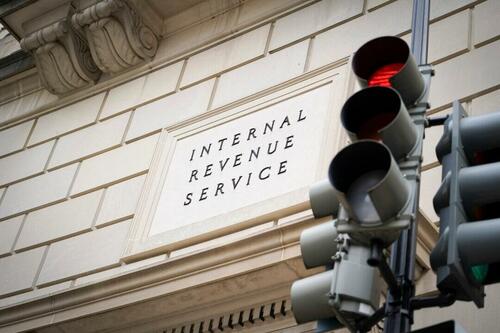Uncategorized
IRS Reveals Suspicious Signs It Looks For To Flag Incorrect Or Fraudulent Tax Credit Claims
IRS Reveals Suspicious Signs It Looks For To Flag Incorrect Or Fraudulent Tax Credit Claims
Authored by Tom Ozimek via The Epoch Times,
The…

Authored by Tom Ozimek via The Epoch Times,
The Internal Revenue Service (IRS) has revealed a series of specific suspicious red flags that could trigger enforcement actions when it comes to mistaken or fraudulent applications for a pandemic-era tax credit.
The IRS indicated in a March 20 notice that there are seven suspicious signs of a bad claim for the employee retention credit (ERC), which is a refundable tax credit designed for businesses that continued paying employees during COVID-19 shutdowns.
The reason the agency is now revealing these telltale signs of incorrect or fraudulent ERC claims is because March 22 is the deadline to apply for a voluntary disclosure program that will let employers who filed bad claims avoid penalties and interest.
Earlier, the IRS found that a large number of improper ERC claims were pushed by predatory promoters on unwitting businesses, with an investigation by the IRS Criminal Investigation (IRS-CI) division uncovering more than $2.8 billion of potentially fraudulent ERC claims.
To fight the wave of dubious ERC claims, the IRS said it had sharply increased compliance action through audits and criminal investigations, with more planned in the future.
However, because of the sheer number of wrongly filed ERC claims and the predatory promotions surrounding them, the IRS developed several ways to get taxpayers who incorrectly claimed the credit to pay it back with minimal penalty.
One of these is the voluntary disclosure program, which lets people who filed bad ERC claims come forward to the IRS and, in exchange for being forthcoming, they only have to pay back 80 percent of what they owe.
Another is a special claim withdrawal process, which lets businesses that filed a questionable claim to withdraw it and avoid the risk of getting an illegal refund that could prove costly.
Generally, anyone who improperly claims the ERC must pay it back, possibly with penalties and interest. The IRS has warned that a business or tax-exempt group could find itself in a much worse cash position if it has to pay back a bad claim than if it had never claimed it in the first place.
The IRS says its latest disclosure of seven warning signs of a bad ERC claim is meant to help businesses review if their claim is questionable and so give them the opportunity to take action by the March 22 deadline.
7 Bad Claim Red Flags
The first warning sign of a potentially bad ERC claim is that it’s claimed for all quarters for which it was available.
Some promoters who pushed employers to file ERC claims advised them to claim the credit for all available quarters, which may not align with eligibility criteria.
“Qualifying for all quarters is uncommon,” the IRS said in the notice, while urging businesses to carefully review their eligibility for each quarter if they want to make sure they don’t fall afoul of the law.
The second red flag that could alert the IRS to a potentially fraudulent or incorrect claim is that it was filed when there was no government order in place that fully or partially suspended the operations of the business claiming the credit.
Some promoters told businesses that they could claim the ERC when any government order was in place in their area, even one that didn’t require the employer to partially or fully suspend its operations.
“This is false,” the IRS said in the notice.
Eligibility for the ERC was limited to periods during which a COVID-19-related order (not guidance or recommendation) was in effect that fully or partially suspended a given employer’s operations.
The third suspicious sign was claiming the ERC for all wages paid to every employee on the payroll.
There were dollar limits and varying ERC amounts, with employers being required to meet certain regulations for wages to be considered qualified wages for a proper claim.
Employers who used the same credit amount across multiple tax periods for each employee is a standout red flag, the IRS says.
The fourth warning sign is claiming a credit solely based on supply chain disruption.
“A supply chain disruption by itself doesn’t qualify an employer for ERC,” the IRS says.
The fifth red flag is employers claiming a credit for the entire calendar quarter when operations were suspended for only part of that quarter.
“It’s possible, but uncommon, for an employer to qualify for ERC for the entire calendar quarter,” the IRS says.
If a pandemic-related government order suspended business operations for part of a given quarter, then the ERC cannot be legitimately claimed for the whole quarter.
The sixth warning sign is that a business that claimed the ERC didn’t employ anyone for part or all of the period for which they’re claiming it.
“Some taxpayers claimed the ERC but records available to the IRS show they didn’t have any employees,” the IRS said. “Others have claimed ERC for tax periods before they even had an employer identification number with the IRS, meaning the business didn’t exist during the eligibility period.”
The seventh red flag for businesses that should alert them that their ERC claim could be bad is if promoters told them that they had “nothing to lose” by filing one.
“Businesses that incorrectly claim the ERC risk repayment, penalties, interest, audit and other expenses,” the IRS says.
The ERC, which is somewhat complex, is available to employers, not individual taxpayers.
Since the program was enacted, over 3.6 million claims have come in, with the IRS saying that ERC-related fraud became worse over time.
Voluntary Disclosure Program
The IRS’s voluntary disclosure program, first unveiled in December 2023, lets employers who wrongly filed for the ERC get right with the tax authorities by admitting to the mistake.
In exchange for volunteering this information, businesses get to keep 20 percent of the incorrectly received credits, and they won’t be charged any interest or penalties on the remaining 80 percent that they repay.
Those that are unable to repay the 80 percent can potentially be approved for an installment agreement, which will let them pay it back over a longer period.
Program applicants must not be under criminal investigation, nor be under an IRS employment tax examination, nor can they have received an IRS notice and demand for repayment of the ERC.
The IRS is also using the program to get at unscrupulous promoters who used aggressive marketing techniques to lure businesses into wrongly claiming the ERC.
In order to qualify for the program, employers must provide the IRS with the names, addresses, and telephone numbers of any advisers or tax preparers who advised or assisted with the claims.
The deadline to apply for the voluntary disclosure program is March 22, 2024.
Interest on money owed to the IRS compounds daily and the failure-to-pay penalty accrues monthly and can rise to as much as 25 percent of the owed amount.
Withdrawal Program
Another program the IRS rolled out in October 2023 was a special withdrawal process that lets businesses that filed a questionable claim withdraw it and avoid the risk of costly penalties and interest.
The withdrawal option lets employers avoid future problems by withdrawing pending ERC claims if they suspect they may have been tricked into filing and have not yet been paid.
Even if a business has received the ERC refund check but hasn’t yet cashed or deposited it, it can still withdraw its claim.
Claims that are withdrawn will be treated by the IRS as if they were never filed, and the agency won’t impose penalties or interest.
Uncategorized
Chapter 11, 7 bankruptcy filings claim more beer, brewery brands
It has been a dark time for beer bands and another well-liked brewery appears to be done for good.

It has been a dark period for beer drinkers. First, the Bud Light controversy made beer drinking — something most people associate with fun — political. That has been followed by a general downturn in beer drinking, especially among younger drinkers.
It's not that nobody drinks beer, but the alcoholic beverage has been fighting a number of trends. Hard seltzer and canned cocktails have seen their market share grow significantly.
Related: Iconic retail chain closing roughly half its stores
That has included major players, including Coca-Cola (KO) , entering the market offering a boozy version of its Topo Chico seltzer and partnering with Brown Forman (BFA) to bring Jack Daniels and Coke to market in ready-to-drink (RTD) cans. Shelves have gotten crowded with options that are not beer, which seems to appeal to younger drinkers.
In addition, beer companies have also suffered from a declining market. That's something the Beer Marketing Industry (BMI) shared in its annual report on the state of the industry.
"The report reveals that beer shipments have fallen by 5% in the first three quarters of 2023, and were on track to fall below 200 million barrels for the whole year. As a result, this would be the lowest level of beer consumption in the USA since 1999, and against a 23% population growth since the turn of the Millennium," The Drinks Business reported.
Image source: Shutterstock
Another brewery appears to be gone for good
The downturn in beer sales, along with debt caused by the covid pandemic, has caused a massive problem for the craft beer business. A number of local and regional breweries have shut their doors because they can't service the debt they had to take on when they were shut down for months during the pandemic.
Casualties have included huge names, including San Francisco's Anchor Brewing, a nationally known brewery. A number of other regional favorites of varying sizes, including Chicago’s Metropolitan Brewing, New Jersey’s Flying Fish, Denver’s Joyride Brewing, Tampa’s Zydeco Brew Werks, and Cleveland’s Terrestrial Brewing, have also filed for bankruptcy.
It's a sort of beerpocalypse that does not appear to be slowing down as another regional favorite brewery, 7 Mile Brewery of Rio Grande, NJ has filed for Chapter 11 bankruptcy protection. The company, which closed in May, filed for bankruptcy in late -February.
The company did share a goodbye on its Facebook page after its last day of operations in May.
"Well that’s a wrap. Thank you to all that came out this weekend to support us. Thank you to all of you for sharing your memories and sending well wishes. We will miss you all. We would also like to thank all our amazing employees through the years. 7 Mile Brewery was all because of you," the company shared.
7 Mile finally files Chapter 11 bankruptcy
It remains unclear why 7 Mile Brewery waited this long to file as it did not appear to be working toward a plan to reopen. The company reported liabilities of $601,000 and assets of $135,000, which is mainly in brewing equipment.
Filing for Chapter 11 bankruptcy protection might allow the company's owners to work out a plan to keep that equipment. That could, in theory, allow them to open in another location or brew beer to sell to wholesalers.
A local radio station, 92.3 The Buzz shared what it believes to be the reason for the filing.
"The craft brewer closed down its operation in May 2023 but has gone to court seeking protection after landlord threats of on-site auctions to sell the property outright.
7 Mile and the other breweries named above are not the only beer brands and breweries that have gone bankrupt and, in many cases, closed their doors.
Deadwords and Persimmon Hollow, two Florida breweries also filed for Chapter 11 bankruptcy earlier this year. Both of those beer brands are trying to stay open.
Forgotten Boardwalk Brewing in New Jersey was not as lucky, having closed down in February. That was the same fate met by The Alementary Brewing Co., another New Jersey brewery which closed after a bankruptcy filing.
In addition, franchise retail chain Craft Beer Cellar filed for Chapter 7 bankruptcy to liquidate its assets, after suffering from financial distress and failing to sell its business.
bankruptcy pandemic
Uncategorized
The relentless growth of U.S. government debt
I was very lucky to attend the Harvard Business School Owner/ Presidents Management program over the three years to 2006. In my class of 100 mature–age…


I was very lucky to attend the Harvard Business School Owner/ Presidents Management program over the three years to 2006. In my class of 100 mature–age students, around half were from the U.S., and the remainder were from several other countries. I know it is a gross generalisation, but it would be fair to say the U.S. students excelled at any “marketing” related case studies but noticeably under-performed in any case studies related to “accounting”.
It is with that backdrop that I thought it worthwhile analysing the data released from the U.S. Treasury, post the release last week for the month of February, and the fiscal year to date being the five months to February 2024. In short, the data, on an annualised basis, is showing a budget deficit of U.S.$2.0 trillion (which exceeds 8 per cent of gross domestic product (GDP) of U.S.$24.6 trillion), whilst the interest expense component of that deficit is running at U.S.$840 billion, or 42 per cent of the annualised budget deficit.

The U.S. Government Debt is now expected to hit U.S.$35.5 trillion at the end of the fiscal year (30 September 2024), around 144 per cent of GDP, and the trouble is this indebtedness is forecast to grow at a much faster rate than GDP over the medium-term.
The graph above illustrates a 10.4-fold increase in U.S. public debt over 33 years to 2023, with an average annual growth rate exceeding 7 per cent. While various governments may blame COVID-19, the cost of defence, demographics, health, welfare, or net migration, neither U.S. political party has striven for a budget surplus over the past 25 years. The problem associated with the increasing level of government indebtedness means any budget deficit will be starting the new fiscal year at close to U.S.$1 trillion in the red (or around 4 per cent of GDP), assuming reasonably steady interest rates.
Dissipating confidence in the U.S. dollar may be one of the reasons gold and bitcoin are challenging their record highs. And at some stage, “the market” may demand a higher premium over the level of inflationary expectations when lending the U.S. government funds. If the confidence level in U.S. bonds eventually comes under pressure, so logically, there will be many asset valuations.
bonds covid-19 bitcoin goldUncategorized
Major healthcare facilities operator files Chapter 11 bankruptcy
50-year-old nursing home operator files Chapter 11 bankruptcy after defaulting on over $50 million in loans.

Operators of nursing homes and senior living facilities were severely impacted during the Covid-19 pandemic in 2020 as about 40% of residents had or likely had Covid-19 that year and over 1,300 nursing homes had infection rates of 75% or higher during surge periods, the U.S. Department of Health and Human Services Office of the Inspector General reported.
The high infection rates led to severe staffing challenges, including significant loss of staff and substantial difficulties in hiring, training and retraining new staff, according to a February 2024 report. Those staffing challenges, however, continue today, as rising inflation makes it more expensive to compensate these essential workers.
Related: Another discount retailer makes checkout change to fight theft
In addition to staffing challenges, operators have also faced a number of economic issues that have driven some of these companies to file for bankruptcy or, in some cases, shut down facilities. Rising inflation, which affects products, supplies and employee wages, and higher interest rates over the past couple years have severely impacted operators' budgets. On top of those economic issues, operators are battling inadequate Medicare, Medicaid and insurance reimbursements that can lead to capital shortfalls.
Senior care facility bankruptcies rise
Financial hardship has led dozens of operators of senior facilities to file for bankruptcy over the past three years, with 13 companies filing petitions in 2021, 12 debtors filing in 2022 and 15 more in 2023, according to Gibbins Advisors.
Notable Chapter 11 filings over the past year have included Evangelical Retirement Homes of Greater Chicago, which filed Chapter 11 in the U.S. Bankruptcy Court for the Northern District of Illinois in June 2023 to sell its assets at auction. Also, Windsor Terrace Health, an operator of 32 nursing homes in California and three in Arizona, filed its petition in the U.S. Bankruptcy Court for the Central District of California in August 2023 listing $1 million to $10 million in assets and liabilities and unable to pay its debts.
More recently, Magnolia Senior Living, an operator of four facilities in Georgia, filed for Chapter 11 protection on March. 19 in the U.S. Bankruptcy Court for the Northern District of Georgia.
Shutterstock
Loan defaults, ransomware attack force Petersen into bankruptcy
Finally, Petersen Health Care, operator of about 100 nursing homes, assisted-living and long-term care facilities in Illinois, Iowa and Missouri, filed for Chapter 11 bankruptcy protection in the U.S. Bankruptcy Court for the District of Delaware on March 20, suffering financial distress from increased overhead, low reimbursements and a ransomware attack in October 2023 that interrupted the company's efforts to bill patients and insurance companies.
The company's financial problems worsened as it defaulted in on payments on over $50 million in loans that led to 19 of the company's facilities to be placed into receivership.
Petersen asserted in a March 21 statement that it will continue to operate its business as normal, as it is seeking court approval of a $45 million debtor-in-possession financing commitment from lenders to fund post-petition operating expenses and working capital.
“Petersen will operate as usual, and our team remains committed to continuing to provide first-rate care for our residents,” CEO David Campbell said in a statement. “We will emerge from restructuring as a stronger company with a more flexible capital structure. This will enable us to continue as a first-choice care provider and a reliable employer for our staff.”
The Peoria, Ill.,-based company, which was founded in 1974, operates skilled-nursing facilities, assisted/independent living communities, memory care services and homes for the developmentally disabled.
bankruptcy bankruptcies pandemic covid-19 interest rates-

 Spread & Containment2 weeks ago
Spread & Containment2 weeks agoIFM’s Hat Trick and Reflections On Option-To-Buy M&A
-

 Uncategorized1 month ago
Uncategorized1 month agoAll Of The Elements Are In Place For An Economic Crisis Of Staggering Proportions
-

 International2 weeks ago
International2 weeks agoEyePoint poaches medical chief from Apellis; Sandoz CFO, longtime BioNTech exec to retire
-

 Uncategorized1 month ago
Uncategorized1 month agoApparel Retailer Express Moving Toward Bankruptcy
-

 International2 weeks ago
International2 weeks agoWalmart launches clever answer to Target’s new membership program
-

 International3 days ago
International3 days agoParexel CEO to retire; CAR-T maker AffyImmune promotes business leader to chief executive
-

 Uncategorized1 month ago
Uncategorized1 month agoGOP Efforts To Shore Up Election Security In Swing States Face Challenges
-

 Uncategorized4 weeks ago
Uncategorized4 weeks agoKey Events This Week: All Eyes On Core PCE Amid Deluge Of Fed Speakers









